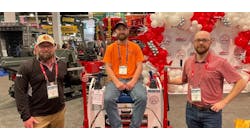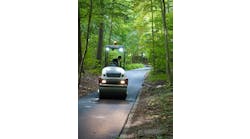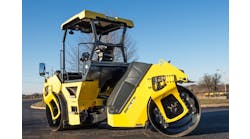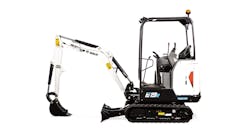There are several reasons why more utility and general contractors are purchasing their own remote-controlled vibratory trench compactors. Strong trends in the construction industry are moving contractors away from the old ways of doing business — when they could bypass soil stabilization practices.
It used to be common that utility contractors simply rolled the tires of their trencher or backhoe over backfilled trenches when they could not bill time spent backfilling and compacting. Solid compaction simply wasn't worth the time and effort. But now, commercial developers, utility contractors and municipalities are becoming more sensitive to settling foundations, trenches and roads. And this is resulting in a surge in trench compactor sales.
Requirements and regulations
Many building engineers and project designers require contractors to guarantee the work and the earth surrounding the site for up to 10 years. Contractors who want to bid on these projects will have to pay closer attention to filling utility trenches and the soil compaction.
Plus, utility contractors are facing increasing regulations. To minimize traffic and pedestrian safety problems, municipalities are requiring utility contractors crossing roads or sewer lines to open and completely close the work trench by the end of the workday. In other words, if a job requires the replacement of an old pipe, the contractor would have to excavate across a street, replace the pipe, backfill to the pre-existing level of material, compact the backfill to its original condition, and lay asphalt down so no one could tell they were there — all in one day.
This limits the amount of trench that can be cut and it puts a lot of pressure on the contractor to work quickly and efficiently. The crew has a limited number of options for speeding up the replacement process. One is to put more men and machinery to the task. But with rising labor rates, adding manpower isn't always a viable option. The second option is to have enough capital to purchase equipment that will make the contractor more productive.
Remote controls
Whether it's a 2-foot, 3-foot or even a 12-foot trench, it's often safer to use a remote-controlled unit for compacting — this avoids the risk of having someone in a trench when adding and compacting backfill. One-man vibratory rammers have their place above ground, but they could cause problems in unshored shoulder-deep trenches.
Government regulations, safety considerations, compaction requirements and guarantees are good reasons to invest in a remote-controlled trench compactor. But if you're new to this exploration process, knowing what separates one machine from another is important. In addition, those looking to purchase a remote-controlled trench compactor need to know what features are key.
“With longer, bigger jobs, contractors have to look at ways to increase their crews' productivity,” says Ingersoll Rand's Matt Gavin. “Since the product is already in the ground and compaction is considered site restoration, they will want to put in the thickest lift of backfill they can, and compact it with the most compaction force they can get — compact as quickly as possible, and move on to the next section. So, contractors should be sure to look for a machine with enough compaction force.”
Other considerations
When looking at trench compactors, check the ease of service — specifically to the drums of the machine. Most contractors will want ease of maintenance and the ability to change from the 33-inch drums to 24-inch drums quickly.
“You can go with a liquid cooled or air-cooled engine,” adds Gavin. “Most contractors prefer liquid-cooled engines since they run quieter in metropolitan or residential areas, where a lot of the infrastructure replacement is being done. Plus they get all of the efficiency and longer life characteristics of a liquid-cooled engine.”
The smaller the “noise footprint” a contractor can make, the better, according to Gavin.
“Many machines look the same side by side,” he says. “Once you run them, though, you can tell immediately if one is running quieter than another.”
It's also important to compare vibration. The machine should be sending its vibratory impact force directly down to the backfill material not radiating it throughout the frame of the unit. This will make a big difference in the structural integrity and overall life of the machine.
Gavin advises to use a compactor with a safety bar feature.
“If you operate the machine manually as a walk-behind, you will need it,” he says. “Safety bars on some machines will stop the hydraulics if it's tripped, but some contractors prefer instead to have the reverse locked out — still allowing the operator to move the machine forward away from hazardous situations.”
Yach is a technical writer for Ingersoll-Rand's Road Machinery Division, Shippensburg, Pa.
Vibromax
Vibromax America manufactures two single-drum rollers: model 1105 (pictured) and 1106. Standard features include a traction control system, 65 percent gradeability on the padfoot, vibration-isolated operator platform, two-speed drive system, over 50,500 pounds of centrifugal force and a centralized hydraulic test station. A 130-horsepower Cummins diesel engine powers the 1105 and a 185-horsepower Cummins diesel powers the 1106.
www.vibromax.de • 800/288-8629
RS #440
NAC
The NAC/Sakai RV Series rammers are available in three models: the RV-60, RV-70 (pictured) and RV-80. Powered by Honda 4-cycle engines, the units feature impacts of 3,000, 3,525 and 4,025 pounds, respectively. According to the manufacturer, the rammers eliminate mixed fuel problems.
800/869-0321
RS #441
Dynapac
The LH 300 vibratory plate compactor is available with Hatz or Honda engine options, delivers 9,000 pounds of centrifugal force and travels at 72 feet per minute. Dynapac recommends the unit for use in compacting applications of sand and gravel. Optional plate extensions are available.
www.dynapac.com
210/474-5770
RS #442
M-B-W
M-B-W's AP2000 vibratory plate now offers an enhanced water delivery system with a 3-gallon water tank for improved asphalt compaction. Features include a reversible handle, replaceable wear edges, a plate force of 3,250 pounds, travel speeds up to 90 feet per minute and an operating weight of 175 pounds.
www.mbw.com • 262/644-5234
RS #443
Bomag
The diesel-powered BT80D vibratory tamper features a 4.4-horsepower Yanmar engine that eliminates the need to mix oil, according to Bomag. Traveling at speeds up to 52.8 feet per minute, the unit can compact up to 3,400 square feet per hour with a maximum compaction depth of 25 inches. The standard 13-inch tamping foot delivers up to 4,000 pounds of compaction force. Optional 9- and 11-inch tamper feet are available.
www.bomag-americas.com • 800/235-0008
RS #444
SuperPac
Available in smooth and padfoot configurations, the 4010 roller from SuperPac Compaction features a 40-inch drum width. The unit is powered by a 28-horsepower Kubota engine and delivers 8,600 pounds of centrifugal force. The flip-top and lockable rear hood provides easy access to engine and pump components.
www.superpac.com • 800/263-7465
RS #446
American Compaction Equipment
The Diamond Compaction Wheel is an attachment for use with most excavators, backhoes, skid-steer loaders and mini-excavators. Thirty base models are available with sizes ranging from 4 to 72 inches and the choice of Sheepsfoot or Wedgepad foot configurations for use in various soil conditions. The units include OEM mounts with pins and a soil leveling plate.
www.acewheels.com • 949/661-2921
RS #445
Stone
The WolfPac 3100 asphalt roller features a double-drum drive, an 18-horsepower Honda engine, internal vibration, center point articulation coupled with a short wheelbase, a tilted steering wheel and high curb and minimum wall clearance on both sides. The unit has a corrosion-resistant water system with a 40-gallon polyethylene water tank and water level gauges. The 3100 is one of five asphalt rollers in the Stone WolfPac line.
www.stone-equip.com
800/888-9926
RS #447
Pangaea Industries
Pangaea Industries is now a distributor of the Tremix line of light construction equipment, including the Tremix MV 80 plate compactor. Powered by a Honda 5.5-horsepower engine, the unit has a vibration frequency of 5,400 vibrations per minute with a centrifugal force of 4,050 pounds. The plate size is 18-by-21 inches and designed to prepare soil prior to concrete work.
219/247-2610
RS #448
Ingersoll-Rand
The TC-13 trench compactor features a radio remote control that operates at 433 megahertz and includes an engine-mounted charger that charges the extra remote battery while the engine is running. The TC-13 has an operating weight of 2,965 pounds, a zero-degree turn radius and a fuel tank capacity that allows for 12 hours of operation. Powered by an 18.9-horsepower Kubota diesel engine, the unit delivers a centrifugal force of 17,000 pounds. According to Ingersoll-Rand, the compactor achieves density requirements in cohesive and semi-cohesive soils.
www.irco.com • 800/526-1090
RS #449
Wacker
Wacker's BS 500, BS 600 (pictured) and BS 700 rammers feature the company's WM 80 engine that has a new variable spark advance ignition system designed to eliminate gas-rich emissions. The 2-cycle rammers are Environmental Protection Agency certified and are designed to reduce emissions, prevent fuel spillage and lower noise levels. Features include a shockmount design, one-lever control, padded handle and a self-cleaning fuel filter. The BS 600 weighs 137 pounds, has an 11-inch wide shoe and produces 3,025 pounds per blow with a compaction depth up to 23 inches.
262/255-0500
RS #452
Hypac
The C754B double-drum vibratory roller from Hypac features 24-inch wide drums and weighs 9,325 pounds. Powered by a 46.4-horsepower Deutz diesel engine, the unit travels at speeds up to 6.2 mph with each drum exerting up to 11,925 pounds of centrifugal force. Other features include a 25-degree articulation angle, a pressurized water spray system with a 60-gallon plastic water tank, two scrapers per drum, inside turning radius of 11 feet, 10 inches. Vibration frequencies of 3,240 or 3,600 vibrations per minute provide optimum compaction on a wide range of materials, Hypac says.
www.hypac.com • 309/853-3571
RS #450
Arrow-Master
The P-Series vibratory plate compactor features a reversible guide handle and double-formed leading edge for improved climbing, Arrow-Master says. The units are available with a Honda, Briggs & Stratton, Robin, Kohler or Kawasaki engine. Centrifugal force ranges from 2,500 to 5,300 pounds and travel speeds reach 135 feet per minute. The roll bar protects engine and components.
www.arrowmaster.com
800/325-4151
RS #451
Tramac
Tramac's boom-mounted vibratory plate compactor is a hydraulically powered attachment for use with small, medium and large tractor backhoes and excavators. Four TraPac compactor models are available. Eliminating the need for manual greasing, the unit's bearing features continuous oil bath lubrication. The high alloy steel unit is equipped with oversized rubber isolators to protect the carrier from vibrations traveling back up into the boom. Other features include narrow base plates that are welded directly to the housing and pin-on swivel-top adapters.
www.tramac.com • 800/526-3837
RS #453
Terex Light Construction
The SP2006 and SP2008 (pictured) soil compactors from Terex Light Construction are available in smooth and pad drums with optional leveling blades to increase productivity. The adjustable steering wheel and easy-access controls ensure operator comfort and its rear-positioned engine and hydrostatic pumps allow for easy maintenance.
www.terex.com • 800/433-3026
RS #454
Multiquip
The Rammax P33/24 HHMR compactor from Multiquip is available in manual and manual/remote control versions. Features include a central lifting eye, clamshell hood, uni-body construction and skid-steer maneuvering. Powered by a 18.5-horsepower Hatz engine, the unit delivers18,500 pounds of compaction force. The solar-powered infrared remote control has 10 transmission channels and the remote transmitter on the unit is housed in a concealed storage box.
www.multiquip.com • 800/421-1244
RS #455





